Category: Automation
Substation Automation System
Understanding SCADA Systems for Substation Automation
Understanding SCADA Systems for Substation Automation: In our rapidly advancing technological world, tools aimed at increasing efficiency, improving safety, and automating mundane processes are constantly being developed and integrated into various industries. In the field of electrical power delivery, one such tool which has seen significant application and development is the Supervisory Control and Data Acquisition (SCADA) system. SCADA is at the forefront of revolutionizing operations, particularly in substation automation, and has been instrumental in enhancing real-time monitoring and control of electrical substations. This exploration into SCADA systems delves into how they function, their role in multiple sectors, and most importantly, their transformative effect on power substation automation.
Overview of SCADA Systems (Understanding SCADA Systems for Substation Automation)
Understanding SCADA Systems
SCADA (Supervisory Control and Data Acquisition) systems are critical for industrial operations as they serve to monitor and control industrial infrastructure or facility-based processes. The SCADA systems are essentially computer systems that collect and analyze real-time data. These systems utilize data communications, graphical user interface, and extended processing capabilities for monitoring and controlling a plant or equipment in industries such as telecommunications, water and waste control, energy, and transportation.
Functioning of SCADA Systems
SCADA systems function by collecting data from remote locations and sending it to a central system for monitoring and control. This is achieved through a Human Machine Interface (HMI), a screen where the user can view and interact with the graphical representation of the system. The SCADA software processes, distributes, and displays the data, enabling operators and other employees to analyze the data and make crucial decisions. Field devices like sensors and control relays, collect data from the process, and send control commands to the process.
Components of SCADA Systems
The key components of a SCADA system include sensors and control relays, Remote Terminal Units (RTUs), SCADA master units, a communication network, and an HMI. Sensors and control relays are used to perform key functions, RTUs convert sensor signals into digital data and send it to the SCADA system. The SCADA master units are computers that serve as the core of the SCADA system, the communication network connects the SCADA master unit to the RTUs and the HMI is the interface where users view the processed data.
Importance and Application of SCADA Systems
A major importance of SCADA is its ability to monitor and control large geographic processes. Its application in different industries ensures operational efficiency, system performance optimization, system breakdown prevention, and direct integration with business systems. It aids in cost reductions, increased productivity, and profitability. In water treatment, for example, SCADA systems monitor and control the water flow, reservoir levels, pipe pressure among other factors.
An Introduction to SCADA Systems in Power Substations for Automation
Power substations frequently utilize Supervisory Control and Data Acquisition (SCADA) systems for automation – a technique that leverages technology to carry out operations with minimal or no human intervention. These SCADA systems play a crucial role in ensuring a consistent and reliable power distribution, enabling utility companies to remotely monitor and govern substations, promptly detect and rectify faults, and significantly cut down instances of power outages. These benefits are not limited to maintaining a smooth flow of real-time information but also extend to bolstering the efficiency, reliability, and safety of the power systems. The proactive detection and rectification of potential issues avert power outages or instability within the grid, effectively emphasizing the importance of SCADA in the smooth operation of power substations.
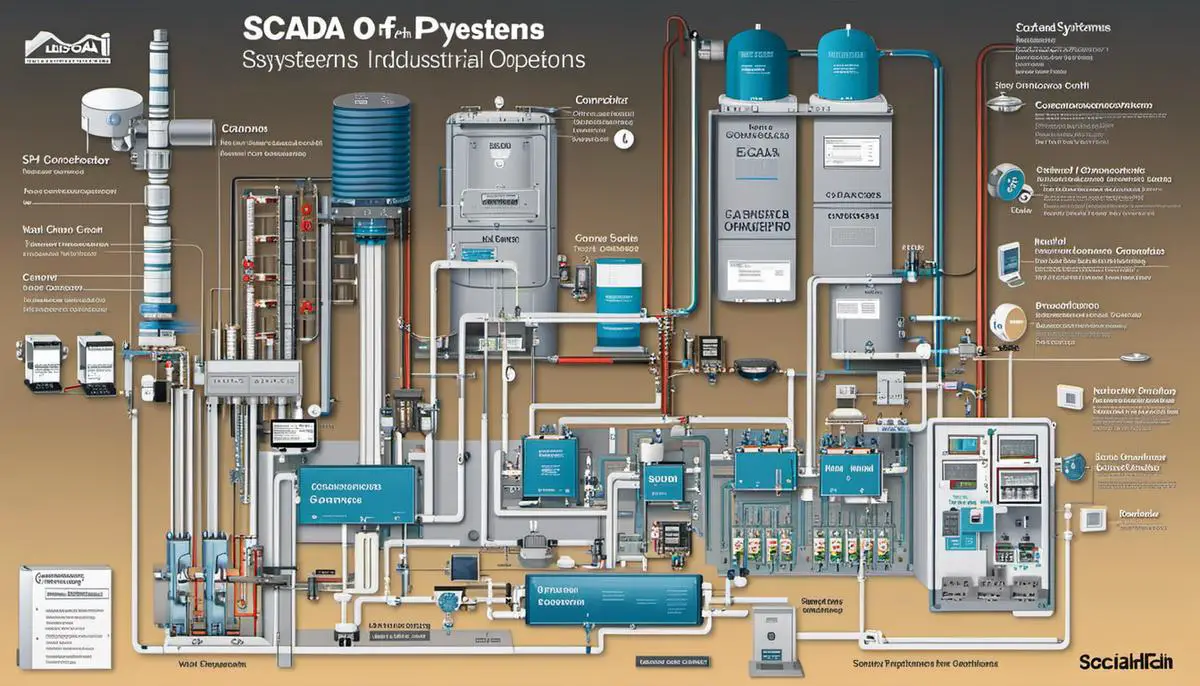
Benefits of SCADA Systems in Substation Automation
The Role of SCADA Systems in Enhancing Substation Automation Efficiency
There is a wide range of benefits associated with employing Supervisory Control and Data Acquisition (SCADA) systems within substation automation, with one of the prominent ones being its significant contribution towards enhancing efficiency. Specifically, SCADA systems allow for the remote and real-time surveillance and administration of electric substations, enabling operators to detect and respond to system changes promptly, thereby facilitating a robust and uninterrupted power supply.
Enhancing Efficiency and Safety: The Power of HMI Software
For instance, when a fault arises within a substation, the SCADA system instantaneously alerts the operators, pinning down the exact loophole. This expeditious diagnosis allows for rapid problem-solving, substantially reducing downtime and consequently optimizing the efficiency of the overall power distribution process.
Reliability Improvements with SCADA Systems for Substation Automation
By incorporating SCADA systems in substation automation, reliability is significantly increased. SCADA systems provide operators with comprehensive and accurate data rendering the condition of the substation. By continuously monitoring all equipment and processes and alerting operators to any anomalies, SCADA systems create an environment where potential failures can be addressed proactively rather than reactively. For example, Duke Energy, a major U.S utility company, reported in 2018 that their SCADA-enabled substations had a 35% decrease in outage durations due to the benefits of real-time fault detection and quick diagnosis.
Enhancing Safety through SCADA Systems in Substation Automation
Safety constitutes a crucial aspect of substation operation, and SCADA systems greatly reduce the risk of dangerous incidents. Given that electrical substations house high-voltage electrical equipment, any malfunction or mishap can result in severe consequences. SCADA systems lessen the need for onsite personnel, lowering the potential for workplace accidents. Furthermore, in the case of potentially hazardous conditions or complex maintenances, SCADA systems manage these situations remotely, ensuring that personnel are not exposed to unnecessary risks.
For instance, Pacific Gas and Electric (PG&E) stated that the digitization initiatives, including SCADA systems in their substation automation, have considerably improved safety records over the past years.
Real-world Applications of SCADA in Substation Automation
SCADA systems are already being widely used in substation automation across the globe. The Singapore Power Grid has installed a SCADA system that monitors and controls over 10,000 different data points from many substations. This system enables the company to quickly respond to electrical outage and voltage fluctuation, maintaining a reliable power supply for over 5 million residents across the country.
In the U.S, Southern California Edison (SCE), one of the largest electric utilities, implemented a SCADA system that resulted in improved operational efficiency and reliability of their power networks. The system allowed operators to remotely control and monitor equipment in their substations, significantly lowering the potential for blackouts, and ensuring a more stable power supply for millions of customers in Southern California.
The benefits of SCADA (Supervisory Control and Data Acquisition) systems for substation automation are many, offering improvements in efficiency, reliability, and safety within power delivery networks. As we continue to adopt and advance this technology, we’ll undoubtedly witness further strides forward within the electrical power industry.
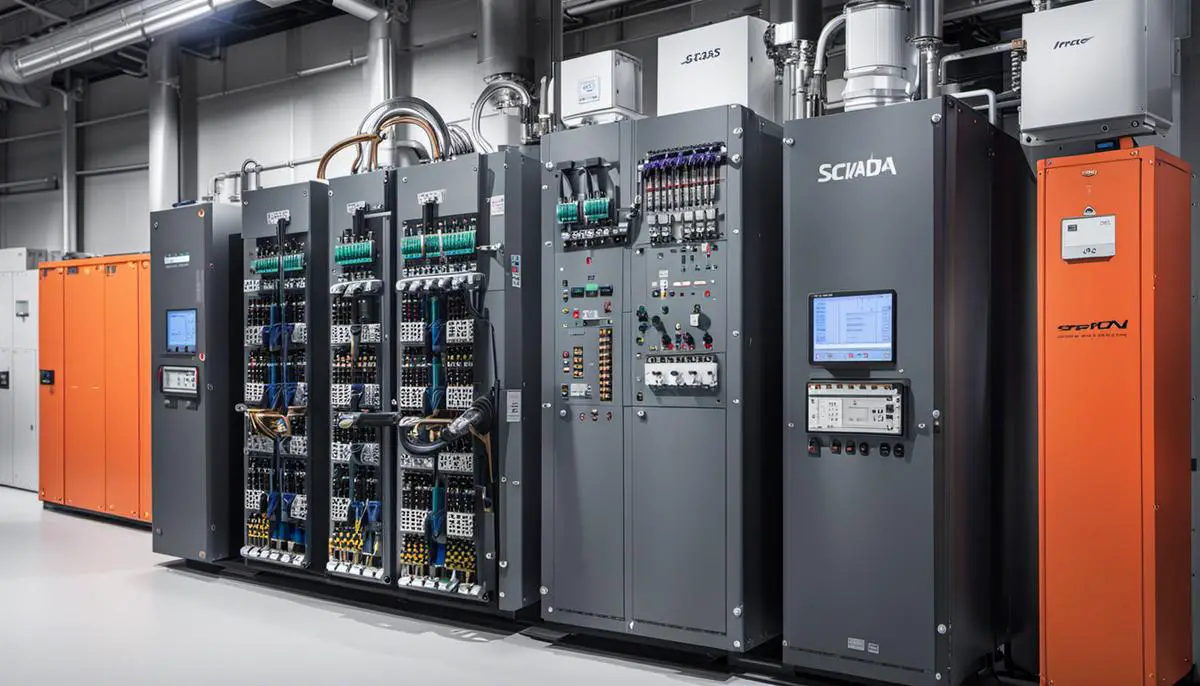
Challenges and Solutions in Applying SCADA Systems
Overcoming Challenges within SCADA Systems for Substation Automation
While the deployment of SCADA systems in substation automation offers significant advantages, it also brings with it certain challenges. Security is of principal concern with these systems, as substations form a critical part of the broader power grid, making them potential targets for cyberattacks. Their complex web of integration with other components and wide-area networks compounds the difficulty of safeguarding these systems.
Interoperability and vendor lock-in present additional obstacles. Some older SCADA systems — proprietary technologies produced by particular manufacturers — may have been groundbreaking when first introduced, but the tasks of integrating them with newer technologies or upgrading them to adhere to modern industry standards have proven problematic.
Furthermore, maintaining high-quality communication and real-time performance against the backdrop of harsh and unstable environmental conditions is a tall order. Substations are occasionally located in remote or difficult-to-access places, further complicating the assurance of reliable data transfer, especially under physical constraints such as high voltage and intrusive interference.
Lastly, the processing of substantial data presents another hurdle. Whilst modern SCADA systems can generate enormous quantities of data, the task of processing and efficiently utilizing that information in critical timeframes can prove daunting.
Addressing Challenges in SCADA Systems
Recently, a multitude of solutions have surfaced to overcome the hurdles tied to the application of SCADA (Supervisory Control And Data Acquisition) systems within the context of substation automation.
What is Remote Terminal Unit? A Basic Guide
Among the greatest concerns is system security. This issue is being challenged with a comprehensive blend of technological tools and organizational strategies, such as encryption, intrusion detection systems, and specially designed secure SCADA protocols. On an organizational level, routine audits, employee training, and robust policy implementation are being used to enhance system defense against cyber breaches.
In the bid to establish greater interoperability and steer clear of vendor lock-in, industries are rallying aid from open standards. Standards such as IEC 61850, crafted to enable smoother equipment integration across multiple manufacturers and forward-leaning designs, are being increasingly adopted.
As for ensuring top-caliber reliability and performance, targeted communication technologies partnered with redundancy methodologies have been beneficial. Employing a mix of wireless and fiber-optic cables and duplicated network structures has proven effective in sustaining dependable data transmission.
Finally, the handling of data overload in SCADA systems necessitates competent data management solutions. This could entail employing advanced analytic tools for transforming raw data to actionable insights or embracing edge computing systems for efficient close-source data processing.
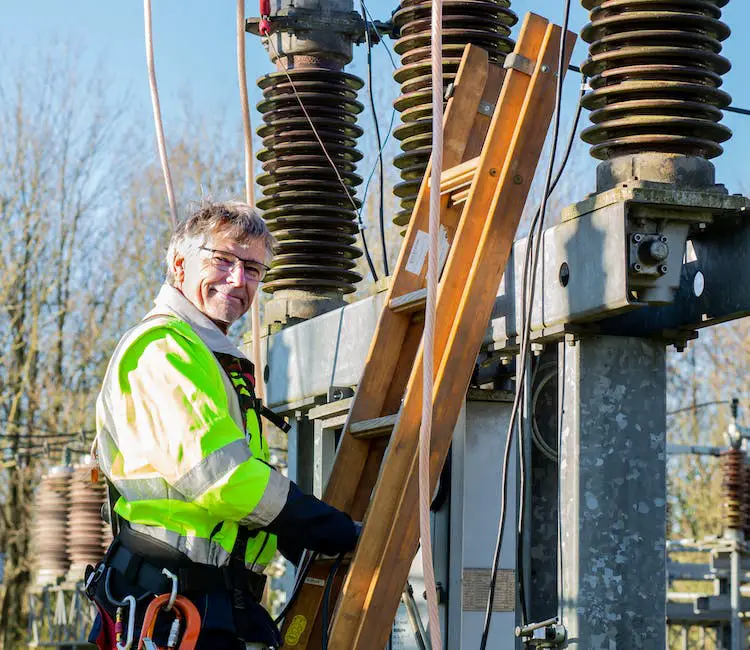
Future Trends of SCADA Systems in Substation Automation
Navigating SCADA Systems in the Sphere of Substation Automation
SCADA systems constitute a crucial element in the automation process of substations. Their function extends to the remote monitoring and management of a variety of equipment spread across large areas, including circuit breakers, sensors, relays, and transformers. In its traditional form, SCADA systems are synonymous with a centralized control model where all decisions are directed from a primary control room. However, the advent of smart grids and the far-reaching influence of IoT (Internet of Things) devices are ushering SCADA systems toward a more decentralized control model.
Future Trends: Decentralization of Control Paradigms
One of the main trends shaping the future of SCADA systems in substation automation is the decentralization of control paradigms. Current developments lean towards distributed control mechanisms where decision-making processes occur at lower levels of the control hierarchy. This approach minimizes the load on the central processor, enhances real-time decision-making, and increases overall system resiliency.
Technologies such as Edge Computing, Industrial Internet of Things (IIoT), and Artificial Intelligence (AI) are facilitating this decentralization. With Edge Computing, SCADA systems can leverage AI-powered algorithms for real-time data processing at the source, enhancing the effectiveness and speed of system responses to dynamic changes in the power grid.
Increased Interoperability and Standardization
Interoperability is another major future trend expected to shape SCADA systems in substation automation. Modern SCADA systems will need to seamlessly interface with different types of equipment, protocols, and software applications. Standardization initiatives such as the IEC 61850, an international standard for automated substations, contribute to enhanced interoperability. This standard facilitates the integration of equipment from different manufacturers, promoting open, flexible, and functionally efficient automation environments.
Integration of Advanced Analytics and AI
Given the increasing complexity and data-intensive nature of modern power systems, incorporating advanced analytics and AI into SCADA systems is seen as a crucial future trend. These advancements provide effective tools for predictive maintenance, failure detection, dynamic load balancing, and anomaly detection. Such insights facilitate smarter decision-making, help prevent downtime, and ensure that power systems operate at optimum efficiency. Machine Learning (ML) models can learn from historical data to predict potential grid failures and optimize load balancing, minimizing energy waste and improving overall system reliability.
Cybersecurity in SCADA Systems
As the world becomes more digitally interconnected, protecting SCADA systems from cyber threats is a growing concern. Future SCADA systems for substation automation will likely employ more robust and sophisticated cybersecurity measures. Defence-in-depth strategies, stronger authentication mechanisms, encryption, and continuous system monitoring are expected to become standard features in SCADA systems.
In conclusion
The future of SCADA systems in substation automation appears bright and promising. Technological advancements and emerging trends such as the decentralization of control paradigms, enhanced interoperability, advanced analytics and AI integration, and improved cybersecurity measures will continue to shape and redefine the landscape of SCADA systems in substation automation.

As we venture deeper into the digital era, it’s clear that SCADA systems will continue to be integral to substation automation. With constant technological advancements, their roles in improving efficiency, reliability, and safety become even more pronounced. Despite the anticipated challenges, tailored solutions continue to be developed, smoothing the way for a more advanced and effective utilization of SCADA systems. The future of SCADA systems in substation automation is indeed promising, with new trends foreshadowing an increased integration of innovative technologies, underlining the continuing relevance and potential of these systems in shaping our tomorrow.
Demystify Substation Automation for Renewable Energy
Demystify Substation Automation for Renewable Energy: In today’s technologically driven world, our reliance on energy, especially renewable sources, has shown a substantial increase. To efficiently manage and use this evolving energy dynamic, technologies like substation automation play an instrumental role. Substation automation, a critical component in smart grid technology, enables the efficient management of power substations, cutting down on manual labor and reducing human error. This essay serves to enlighten the reader on the functionality of Substation Automation, its advantages, challenges, and specific importance in harnessing renewable energy. Moreover, it sheds light on the future trends in this technology, offering a glimpse into what the future of energy management might entail.
Understanding Substation Automation (Demystify Substation Automation for Renewable Energy)
Understanding Substation Automation
Substation automation refers to using control and data acquisition equipment to automate the functions of a power substation. This equipment includes a variety of sensors, controls, breakers, and communication technology. With an automation system in place, a substation becomes capable of controlling and monitoring equipment and processes remotely, thereby reducing human intervention and minimizing errors.
Substation automation systems deliver real-time information, enabling more efficient operation and maintenance. Such systems involve a high degree of automation to handle tasks such as energy measurement, fault detection, and event logging.
The core elements of substation automation include hardware components like programmable logic controllers (PLCs), remote terminal units (RTUs), intelligent electronic devices (IEDs), and software applications.
Major Components of Substation Automation
An integral component of substation automation is the IED, which is programmed to perform control, protection, and measurement functions. It can gather and analyze data from multiple sources and make decisions independently.
Enhancing Efficiency and Safety: The Power of HMI Software
Another major component is the communication network, which allows for the exchange of information between IEDs and control centers.
The energy management system (EMS) is also a key player in substation automation. The EMS aids in monitoring, controlling, and optimizing the performance of the power generation, transmission, and distribution process.
Finally, there are gateway devices or protocol converters, which help in connecting control systems with multiple protocols, making the system interoperable and flexible.
The Significance of Substation Automation in Renewable Energy
Substation automation is a pivotal part of the renewable energy sector. Given that renewable energy sources, such as wind farms, solar parks, or hydroelectric power stations, are often found in distant, hard-to-reach locations, manual supervision is not only time-consuming but also ineffective.
Thanks to automation technologies, it’s possible to remotely monitor and control substations, thereby enhancing their reliability and efficiency. Take a wind farm, for instance; automated substations can keep an eye on the wind’s velocity and direction and alter the tilt of the wind turbine blades as needed for optimal power generation.
Substation automation can also harness the inherent variability of renewable energy sources, enabling production prediction and demand management. This is essential for maximizing the use of renewable energy, minimizing waste, and guaranteeing a consistent supply of power to the grid.
Furthermore, substation automation can help tackle the challenges associated with integrating renewable energy into the power grid. Through the input provided by IEDs, operators can swiftly detect and rectify issues that may hinder the grid’s smooth operation — such as unexpected power surges or frequency variations — in real time.
In essence, substation automation is vital not just for improving the operations of power substations, but also for promoting better optimization and incorporation of renewable energy into the power grid.
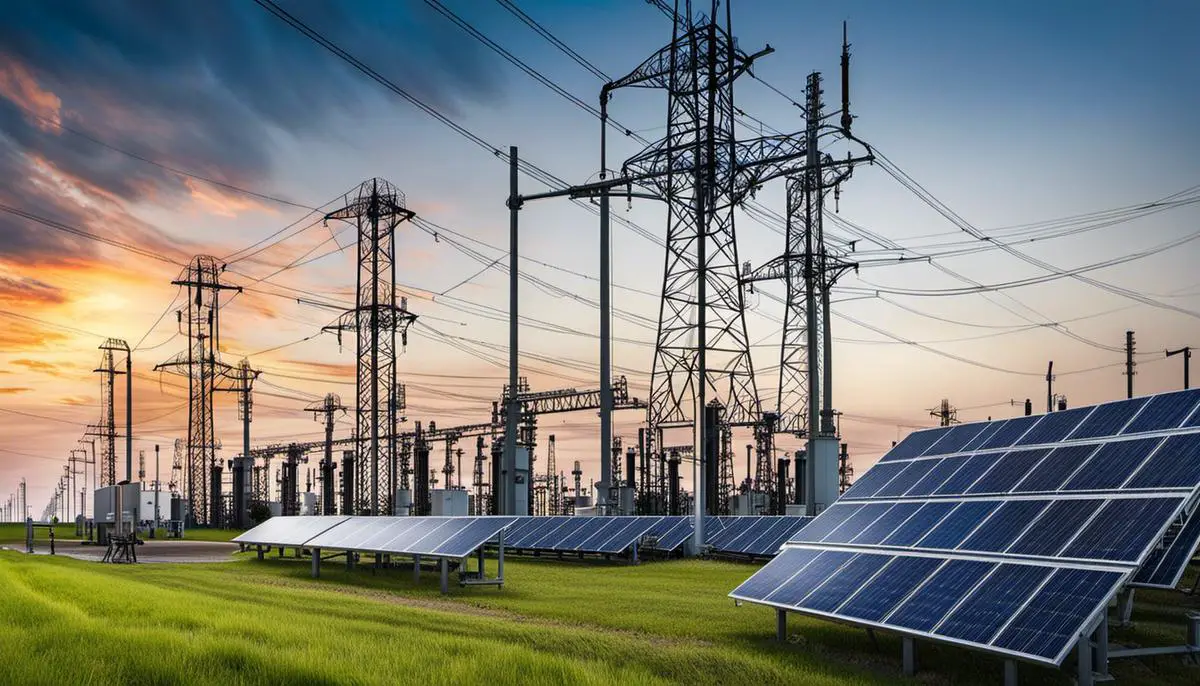
Advantages and Challenges of Substation Automation
Appreciating Substation Automation and Its Value for Renewable Energy
At its foundation, substation automation is a method employed in electrical power systems to utilize data obtained from a series of intelligent electronic devices (IEDs) within substations. The purpose of this data application is two-fold: it enables remote control and supports the optimal usage of the substation. The method is gaining traction given its potential in enhancing efficiency and reliability, notably in the realm of renewable energy operations.
The demand for substation automation systems in the renewable energy era is driven by the dynamic and unpredictable nature of renewable energy sources. Given these energy sources are highly dependent on ever-changing environmental circumstances, they demand far more extensive monitoring and control compared to traditional, fossil fuel-based energy sources.
Understanding Substation Automation & IoT Concepts: A Complete guide for beginner
Advantages of Substation Automation in Renewable Energy
One of the main benefits of employing substation automation in the renewable energy sector is improved efficiency. The automation process allows technicians to manage and adjust the energy sources remotely, improving operational efficiency. Technicians can utilize real-time data to identify potential issues and make the necessary adjustments, resulting in minimized downtime.
Moreover, the implementation of substation automation significantly increases reliability. The automation guarantees continual monitoring of power flows and devices. This continual monitoring leads to quick detection of possible faults and immediate action to prevent or reduce power outages, critical when dealing with erratic renewable energy sources.
Another advantage of automation is the convenience of remote control. The ability to operate and manage the substation from a remote location reduces risks for technicians and simplifies the process. It also saves time and resources by eliminating the need for manual monitoring, particularly beneficial in remote or hard-to-reach renewable energy generation sites.
Challenges in Implementing Substation Automation in Renewable Energy
While the advantages are clear, there are also challenges in implementing substation automation. Technical difficulties and requirements often present initial hurdles in the implementation process.
Installing an automation system requires a high initial investment, mainly due to costs for IEDs, software, and infrastructural adjustments. This cost can be inhibitive for small-scale renewable energy plants, presenting a significant barrier to adoption.
Another challenge is the complex nature of automation. Implementing and managing substation automation requires a specific set of technological skills and a deep understanding of the systems involved. The lack of trained personnel can delay the proper installment and operational continuity of automated systems.
Finally, although automation reduces the risk of manual error, it opens the door to a new potential risk -cyber threats. Automated substations could become targets for cyber-attacks seeking to disrupt power supply, an issue that must be thoroughly addressed throughout the system’s design to ensure robust security.
Turning Challenges into Opportunities
Overcoming the hurdles associated with substation automation for renewable energy sector is entirely plausible. Collaborative efforts and strategic funding from both private and public sectors can significantly decrease costs and provide platforms for education and training. Moreover, strengthening cybersecurity protections can counteract potential threats and pave the way for a broader and more successful implementation of automation in the renewable energy field.
What is Remote Terminal Unit? A Basic Guide
The role of substation automation in renewable energy holds promise for the future, emphasizing efficiency, dependability, and remote management. Even with the challenges involved, the inherent advantages are making these systems a valuable part of our renewable energy future.
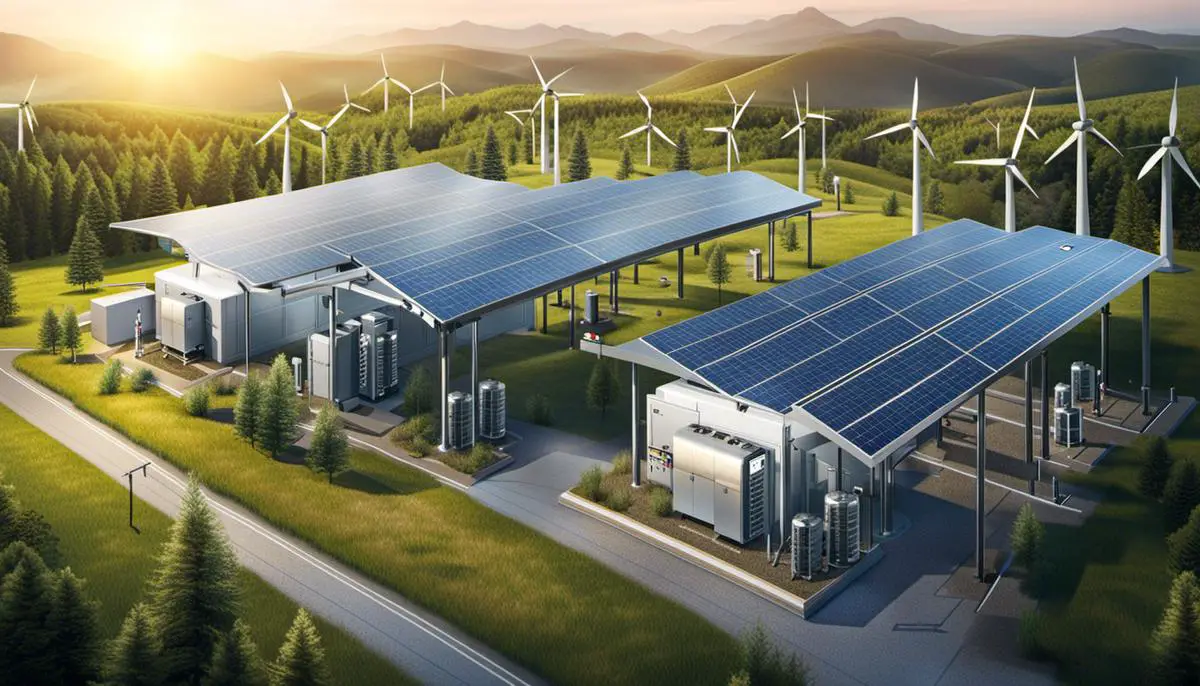
Substation Automation in the Renewable Energy Industry
The Role of Substation Automation in Renewable Energy
Substation automation plays a paramount role in handling power derived from renewable sources like wind, solar, and hydroelectric energy. Substation automation systems (SAS) are engineered to automate and govern the operations of substation infrastructure and the high voltage capacity from renewable energy sources. The system incorporates various intelligent electronic devices, programmable logic controllers, and other technologies to boost efficiency in renewable energy implementation.
Cirebon Power Substation Automation Training
Role of Substation Automation in Renewable Energy
The renewable energy sector significantly relies on substation automation for effective power management, fault detection, and real-time response. The SAS provides grid operators with valuable data on power generation and flows, allowing them to make informed decisions about power distribution and management. The automation also helps predict and prevent potential disruptions, thanks to predictive analysis capabilities.
Enhancing Power Handling Efficiency
Substation automation greatly enhances the handling of power in renewable energy systems. It provides real-time monitoring and control of the power transmission process, increased power system reliability, power quality measurement, and fault detection. Through automation, substations can effectively convert the power generated by wind, solar, or hydro resources into consumable electricity, meeting the demand in a more stable and efficient manner.
Real-World Examples
In the real world, examples of substation automation in the renewable energy sector are plentiful. In China, for instance, a solar power plant in Dunhuang utilizes a highly automated substation to effectively handle the 10-megawatt power generated from solar panels. The system not only ensures a steady flow of power to the grid but also provides predictive maintenance data and real-time performance metrics.
In Portugal, a wind farm relies on the substation automation system to maintain the balance between power generation and delivery to the grid. Automated substations monitor wind speeds and adjust turbine operations accordingly, ensuring optimal power generation and minimizing the risk of equipment failure due to extreme weather conditions.
Driving Efficiency with Green Energy
The role that substation automation plays in the effective management of green energy resources cannot be overstated. This technology enables intelligent control and distribution of power, effectively reducing energy waste. The predictive capabilities and real-time responsiveness of substation automation systems allow renewable energy sources to perform optimally. As a result, this minimizes grid instability and energy loss, further bolstering our efforts towards environmental sustainability.
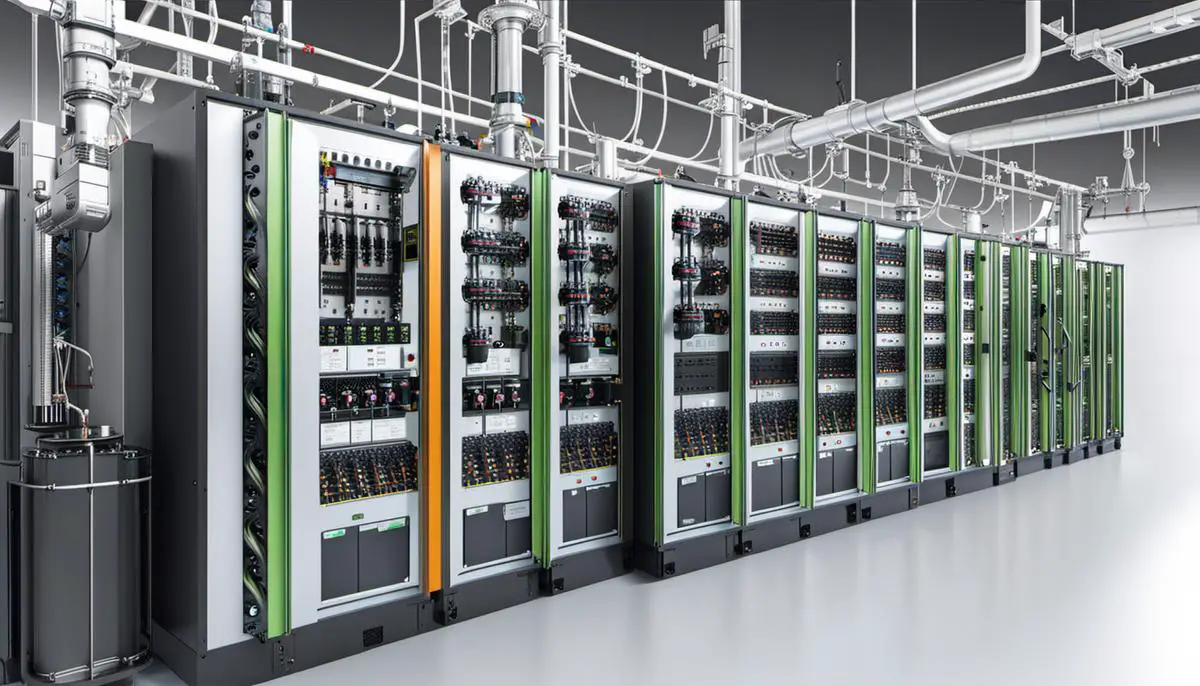
Future Trends in Substation Automation
The Role of Substation Automation in Supporting Renewable Energy
Substation automation is a critical element in today’s energy landscape, more so for renewable energy sources such as wind and solar power. By fostering the creation of smarter, more efficient, and rapidly responsive systems, substation automation significantly improves flexibility, reliability, and energy efficiency. More than that, it facilitates the seamless integration of renewable energy resources into the power grid. This smooth transition from traditional energies to sustainable alternatives stands testament to the functionality and potential of substation automation.
Incorporation of AI in Substation Automation
One of the most promising future trends in substation automation is the incorporation of artificial intelligence (AI) and machine learning (ML). These technologies are particularly suited to managing the complex, rapidly changing data streams that are characteristic of energy management. They offer a faster, more efficient means of analyzing data to identify and respond to events such as faults, outages, and equipment failures.
AI and ML could automate more of the substation’s operations and maintenance tasks. For instance, AI-based systems can predict when equipment might fail based on previous patterns and allow for timely maintenance. ML algorithms can identify anomalies in the system’s operation, leading to early fault detection and prevention. Thus, system faults and maintenance can be predicted and addressed in real time, minimizing energy loss and reducing downtime.
Beyond AI and ML: Integrative Tech Innovations
Looking beyond AI and ML, other technological innovations, such as wireless communication, cloud computing, and the Internet of Things (IoT), are also likely to shape the future of substation automation. IoT devices can collect a vast amount of data from across the substation, which can then be analyzed to optimize operations and identify maintenance needs almost instantly. Meanwhile, cloud computing promises real-time communication and data sharing between substations. This could facilitate power management and distribution across large geographical areas, providing a more effective way to balance the supply of renewable energy to meet demand.
Wireless communication makes it possible to send and receive data and commands in real-time to and from different points in the energy grid, providing significant advantages in monitoring and controlling the substation automation system. It makes the system more robust, flexible, and scalable.
Impacts on Energy Management and Renewable Energy Industry
The implementation of these technologies in substation automation could dramatically transform the energy management landscape and the renewable energy industry. By providing a higher degree of control and responsiveness, these innovations not only optimize the operation of individual substations but also enable them to function more effectively as part of a broader energy network.
As renewable energy sources often generate power unevenly, being able to rapidly adjust how energy is distributed within the grid is crucial. Advanced substation automation technologies can help to meet this challenge, contributing to more stable, reliable energy delivery.
Final Thoughts
Substation automation is an essential asset in the renewable energy industry. As we look to the future, incorporating AI, ML, IoT, wireless communication, and other innovative technologies will transform substations into smart, reliably automated units capable of supporting the green energy transformation. This will significantly impact energy management, promoting sustainability and efficiency across the renewable energy sector.
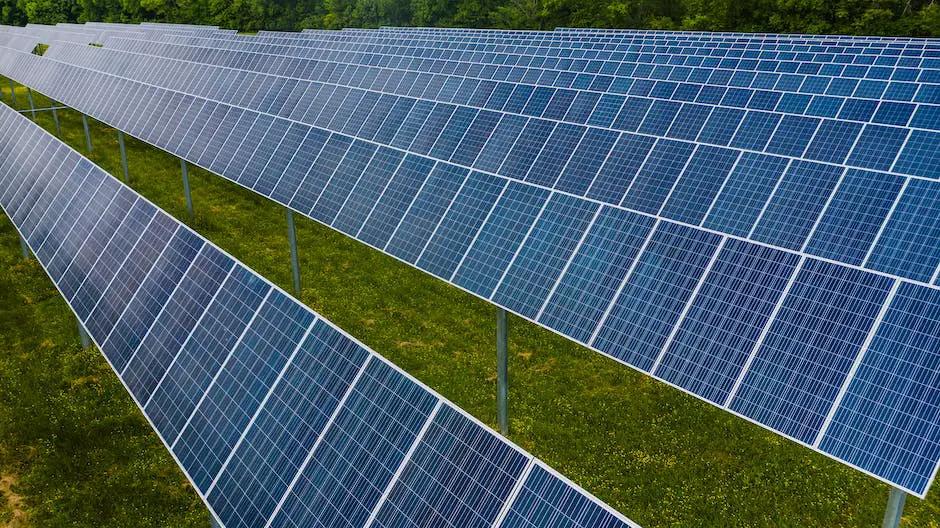
As we move forward, the technologies influencing our everyday lives and driving significant sectors, like energy, are expected to become more advanced and intricate. Substation Automation stands as a testament to this progression, bringing efficiency and ease into the process of power management and delivery. It not only influences the way we manage conventional energy but also plays a major role in effectively capturing and utilizing renewable energy. Keeping an eye on the future trends of Substation Automation, like the integration of AI, grants us an insight into a future where cleaner, greener, and more efficient energy usage becomes a reality for everyone.
Understanding Substation Automation & IoT Concepts: A Complete guide for beginner
Understanding Substation Automation & IoT Concepts, Delving into the intersection of technology and electricity, we embark on a fascinating journey through the world of substation automation and the Internet of Things (IoT). In the modern digital age, innovations are weaving an intricate network where physical objects can interact with each other, and software applications to exchange data and react according to pre-set protocols.
Substation automation, an integral part of smart grid technologies, and IoT usher an era where transformers, circuit breakers, and other substation components are being designed to communicate and operate intelligently. In the forthcoming segments, we will demystify substation automation, introduce the concept of IoT, explore their convergence, examine potential challenges, and envisage the future of these combined technologies.
What is substation automation?
Understanding Substation Automation: The Basics
Substation automation refers to using a system of software and hardware arrangements to monitor and control power system elements from a remote location. The term “substation automation” emerged in relation to systems that aid in the collection and analysis of real-time data, enhance operational functionality, improve power system reliability, and optimize asset management.
Enhancing Efficiency and Safety: The Power of HMI Software
This concept sits at the nexus of electrical engineering and computer science, utilizing elements from both domains to create a seamless, efficient, and safe electrical power substation. The linchpin of a smart grid, substation automation is the brain behind the operations, controlling, and monitoring systems without any human intervention.
Substation automation, in essence, is a system of interlocked intelligent electronic devices (IEDs), including protective relays, controllers, switches, and circuit breakers, connected to a network. These devices perform key functions such as measurement, control, monitoring, diagnostics, and communications within the substation environment. This enables critical real-time data to be collected and analyzed to make quick decisions regarding grid functioning.
The Importance of Substation Automation
Substation automation is a critical component of modern power distribution systems. With the increasing complexity and interconnectivity of electrical networks, the need for efficient and reliable automation solutions has become more evident than ever.
One of the key benefits of substation automation is improved operational efficiency. By automating various processes and tasks, such as fault detection, isolation, and restoration, substations can operate more efficiently and respond quickly to any issues that may arise. This ultimately leads to a more reliable power supply and reduces downtime for consumers.
Another advantage of substation automation is enhanced monitoring and control capabilities. Through the use of advanced sensing and monitoring technologies, operators can collect real-time data on various parameters, such as voltage levels, current flows, and equipment status. This data enables them to make informed decisions, identify potential problems, and take corrective actions promptly.
Read Also: Function Substation Automation System
The Role of IoT in Substation Automation
The Internet of Things (IoT) is a revolutionary concept that has transformed various industries; the power sector is no different. IoT-based devices help collect, analyze and transmit valuable data from substations to a centralized location in real-time, thereby enabling quicker decision-making.
The inclusion of IoT in substation automation has paved the way for more advanced and efficient systems. IoT-based sensors equipped on substation devices provide real-time data related to voltage levels, current flow, temperature readings, and more. This data is then processed, analyzed, and actions are taken such as tripping a breaker or adjusting voltage levels, contributing to the effective functioning of the power grid.
IoT has redefined predictive maintenance within substations. Instead of scheduled field visits, continuous real-time condition monitoring enables potential faults to be detected before they lead to bigger setbacks, minimizing downtime, reducing maintenance costs, and ultimately improving grid reliability and efficiency.
Introduction
Substation automation, greatly aided by the Internet of Things (IoT), has evolved over time from a simplistic remote control system to a fully interfaced, technologically advanced, proactive control system. This fast-growing field offers the potential to significantly transform the energy sector by improving operational efficiency and paving the way for smarter and more environmentally friendly grid systems.
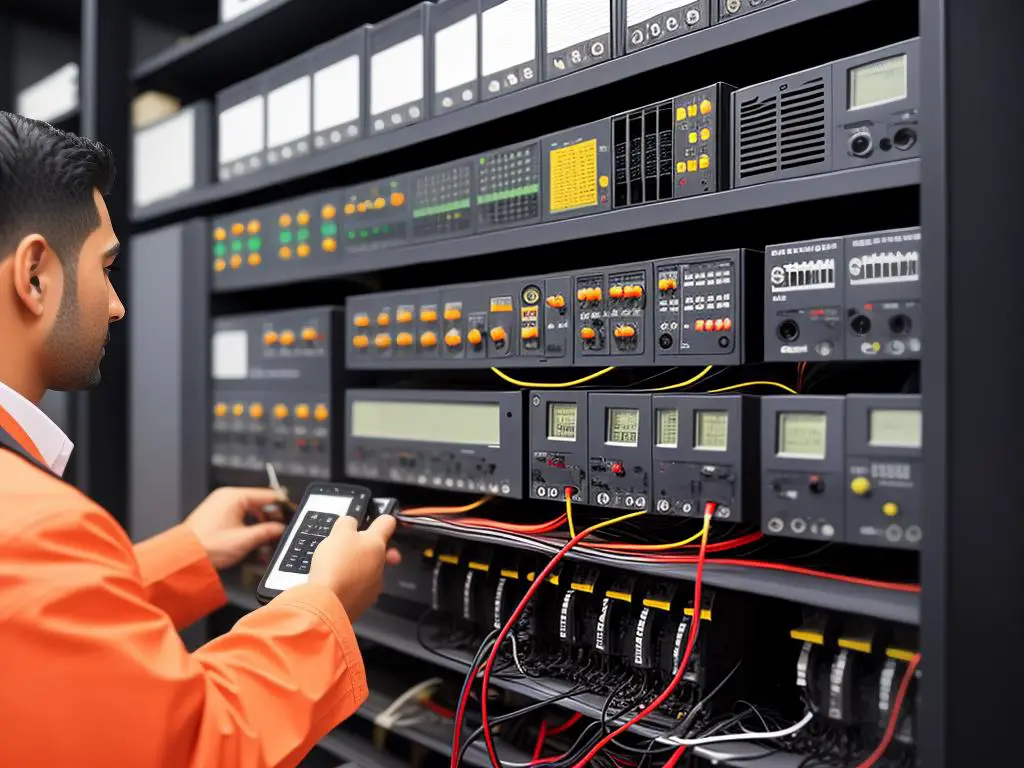
Understanding the Internet of Things (IoT)
Exploring the Internet of Things (IoT): How it Works and What it Does
One of the technologies spearheading this transformation is the Internet of Things (IoT), which is going beyond expectations across various industries. The IoT represents a network of digital devices interconnected and capable of internet connectivity, which facilitates information communication amongst the devices themselves and with humans. IoT devices vary greatly, extending from daily use items like refrigerators or doorbells to sophisticated industrial machinery.
In essence, IoT devices are usually equipped with software or sensors that allow data collection and exchange. This captured data is typically transmitted to a centralized system where it’s analyzed and decoded into valuable insights. These insights can enhance efficiency, enable effective monitoring, and aid informed decision-making. This versatility has seen IoT find relevance in various sectors including industrial automation, healthcare, agriculture, energy, and transportation to name a few.
IoT in Substation Automation
One of the sectors where IoT has made significant strides is in power utility, more specifically, Substation Automation. A substation is a critical part of any electrical generation, transmission, and distribution system. It helps transform voltage levels and facilitate the smooth and efficient transmission of electricity over long distances.
Substations were primarily manual in the past, demanding labor-intensive monitoring and maintenance. However, with the advent of IoT, substations are becoming increasingly automated. IoT facilitates the integration of various intelligent electronic devices (IEDs) in substations, enabling remote monitoring, control, and protection of the utilities involved.
Advantages of Incorporating IoT into Substation Automation
The integration of IoT into substation automation comes with numerous advantages. Firstly, IoT can lead to significant cost savings in maintenance. Instead of having regular maintenance schedules, IoT-enabled devices can report their status in real-time, allowing maintenance to be performed just when it’s needed.
Secondly, IoT enhances the operational efficiency of the substations. By providing real-time data about system performance, operators can make timely decisions, hence preventing possible faults and enhancing the life and reliability of the components.
Thirdly, IoT-enabled substation automation systems allow for seamless integration of renewable energy sources into the grid. These systems are capable of managing the variability and decentralization of renewable sources with their enhanced control capabilities.
Lastly, in the case of any faults or power outages, IoT systems are programmed to generate instant alerts with details about the fault’s location and nature. This makes it easier for the utility companies to quickly identify the issue and reduce the restoration time.
Embracing the Future: Substation Automation and IoT
Integration of the Internet of Things (IoT) into substation automation presents challenges, particularly in ensuring data security and maintaining privacy. Yet, thanks to the ever-advancing technology and implementation of stringent preventive measures, these potential risks are being steadily managed.
As we look towards a future where smart grids will likely become the norm, the role of IoT in substation automation is anticipated to expand. As this transition to a further digitized era takes place, the interaction between IoT and substation equipment will continue to refine, resulting in a power system that is more reliable, efficient, and resilient.
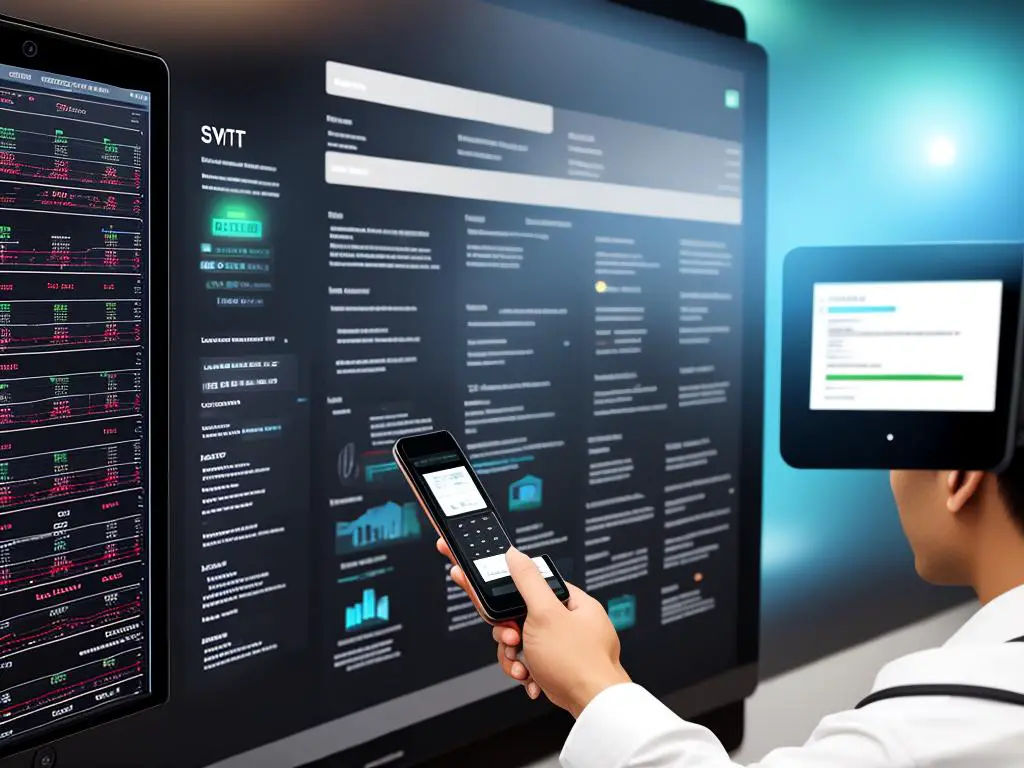
How does IoT apply to substation automation?
Powering Up Efficiency: The Integration of Substation Automation and IoT
Substation automation plays a crucial role in electrical power systems, improving reliability, efficiency, and safety. It is primarily responsible for managing several intricate processes such as real-time monitoring, control, relay, protection, and communication. With the advent of the Internet of Things (IoT), which enables physical devices to collect and exchange data through a connected network, these functions are further enhanced and streamlined.
Enhancing Efficiency and Safety: The Power of HMI Software
When combined with IoT, an automated substation can operate even more efficiently and reliably, contributing to a higher level of safety and leading to a more sustainable, economical distribution of electricity.
Revolutionizing Substation Operations with IoT Applications
The application of IoT in substation automation has numerous benefits. It allows for more accurate monitoring and controlling of substations by facilitating data exchange between multiple devices, allowing for quicker identification and resolution of faults. It improves system reliability by providing real-time information about equipment status and performance patterns, enabling earlier detection of potential issues. Lastly, it fosters safer maintenance operations by allowing remote control and monitoring, hence reducing the need for personnel at hazardous locations.
Smart sensors incorporated into the IoT infrastructure can track voltage, currents, and temperature for the substation’s remote terminal units (RTUs). These sensors collect data and send it back to a central server through their wireless network. This type of system enables electricity supply companies to monitor their substations remotely, identifying potential issues before they become major problems.
Real-world Applications of IoT in Substation Automation
Several practical applications demonstrate the successful integration of IoT with substation automation. In advanced power grids, IoT-enabled devices can collect data from various locations, consolidate it, and send it to a central location for further analysis. This method reduces the risk of unexpected equipment failure, lowers maintenance costs, and promotes efficient use of resources.
Distribution automation devices like automated meter-reading (AMR) systems also use IoT technology. These systems measure electric energy consumption, detect abnormalities (like a power outage or theft), and transmit this data remotely to the utility company. They can also allow the rapid isolation of faults on the distribution network, restore power quickly, and reduce outage times.
The marriage of the Internet of Things (IoT) with substation automation is dramatically reshaping the landscape of power generation, transmission, and distribution. This blend of technologies makes it possible to gather wide-ranging data which can be used to optimize various processes involved in power system operation and its maintenance. As time goes on, the synergy of IoT and substation automation will continue to propel advancements not just in electrical power systems, but also in the wider energy sector.

Challenges and solutions of implementing IoT in substation automation
Obstacles in Incorporating IoT in Substation Automation
Despite the many benefits, integrating IoT technology into substation automation is not without its sets of hurdles. These span across different areas such as cost implications, compatibility issues, and concerns over security risks, among others.
Potential Solutions for Implementing IoT into Substation Automation
Despite the numerous challenges, viable solutions exist for successful implementation of IoT in substation automation.
The Cost Challenge
The cost of implementing IoT in substations is substantial. Major financial investments are required for the purchase of IoT devices, software and services, maintenance, and employee training. Moreover, the rapid advancement of technology necessitates constant upgrades, which can be financially taxing for many companies.
To tackle the high cost of implementing IoT, careful financial planning is required. Companies can plan for phased implementation, where the implementation is done gradually over a period of time. This approach minimizes the impact of costs, as instead of a lump sum, investments are spread out over time. Additionally, it is important to prioritize investments on the most necessary IoT devices and applications.
The Compatibility Concern
Compatibility remains a major concern when integrating IoT in substation automation. Often, the IoT devices and applications utilized in substations are not compatible with each other or with the existing infrastructure of the substation. This results in disjointed operations and hampers the realization of the full benefits of IoT technology.
Compatibility can be ensured through the standardization of IoT devices and applications. Organizations such as the Institute of Electrical and Electronics Engineers (IEEE) have set out standards for IoT devices. Adherence to such standards ensures compatibility and interoperability between IoT devices applied in substations.
The Security Risk
The issue of security risks, particularly cyber-attacks, cannot be overstated. The introduction of IoT devices in substations expands the attack vector, thus making substations more susceptible to risks such as unauthorized access, information theft, and crippling of the substation’s operation.
Cybersecurity risks can be mitigated by adopting robust security measures. Adequate and up-to-date data encryption methods should be utilized to ensure the security of operational and nonoperational data. Regular security audits and intrusion detection systems can also be used to identify and fend off cyber threats.
Employee Training
Moreover, employee training should be prioritized to ensure the staff are adept at handling IoT systems. Well-trained employees will be more equipped to detect anomalies and be more effective in maintaining optimal operations of the substation.
Conclusion
Summing up, it’s clear that while there may be potential trials and security risks associated with implementing IoT in substation automation, these issues can be effectively handled through strategic planning, standardization, robust cybersecurity strategies, and thorough staff training. The ultimate objective is the enhancement of efficiency, reliability, and overall effectiveness within power generation, transmission, and distribution systems.
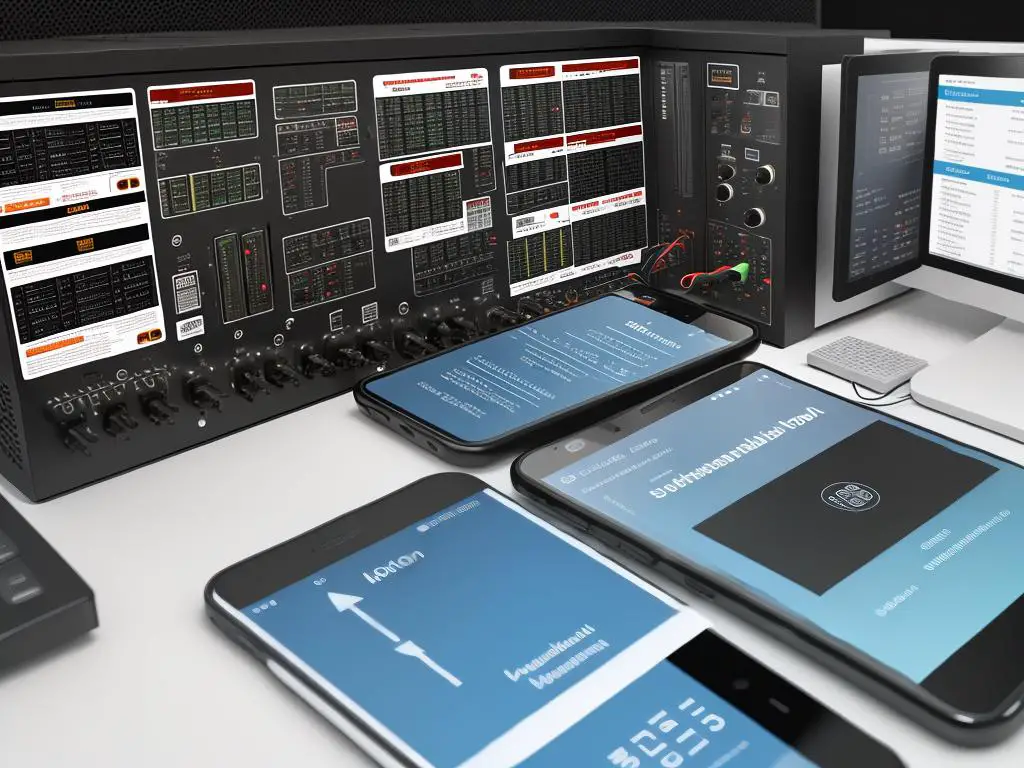
The future of substation automation with IoT
A Brief Look Into Understanding Substation Automation and IoT
Substation automation plays a critical role within power systems’ transmission and distribution processes. This method integrates a variety of intelligent electronic devices (IEDs), automation technologies, and communication networks into a power substation. The aim of this integration is to allow for detailed monitoring, controlling, and protective measures over the substation’s electrical equipment.
Simultaneously, the Internet of Things (IoT) is a technology that allows physical devices, vehicles, home appliances, and more to connect and communicate. This networking happens through embedded sensors, software, or connectivity, making remote monitoring and control possible.
The fusion of substation automation and IoT is designed to not only boost efficiency and reduce operational costs but also optimize asset utilization. Furthermore, it seeks to enhance the system’s reliability and security within the power sector.
Emerging Trends in Substation Automation and IoT
One emerging trend in the substation automation and IoT space is the adoption of wireless technology. Given the vast amounts of data that need to be exchanged between devices, wireless technology is considered a cost-effective and efficient solution. It allows the transmission of real-time data from a substation with minimal delay and less complexity in the transmission infrastructure.
Another trend is the growing use of artificial intelligence (AI) and machine learning (ML) in substation automation systems. These advanced technologies are being used to analyze and interpret data, predict equipment failures, and enhance system reliability and efficiency.
Ongoing Research in Substation Automation and IoT
Research in this field is focused on improving and advancing the communication network architecture and developing new intelligent electronic devices (IEDs), automation technologies, and software. For instance, researchers are looking into fully integrated, robust, and secure communication networks that could withstand heavy data traffic, weather conditions, and security threats.
There is also ongoing research into developing new IEDs that are more efficient, reliable, and can communicate effectively with other devices. This includes advanced protection relays, power quality equipment, and fault detection devices.
The Future of Substation Automation and IoT
The future of substation automation and IoT looks promising with several expected advancements. One significant development is the integration of renewable energy resources. With the growing importance of renewable energy, future substations will likely be equipped with automation systems and IoT devices that can handle the dynamics and intermittency of renewable energy sources.
Furthermore, the future holds a highly automated and digitized substation environment, where all equipment will be connected, and operations will be remotely controlled.
Advanced cyber-security measures are an essential aspect of the future of substation automation and IoT. Given the increasing frequency of cyber-attacks and the rising interconnectivity between devices, techniques will need to be developed to secure not only the data but also the entire substation automation system.
Overall, the future of substation automation and IoT paints a picture of a highly efficient, reliable, secure, and sustainable power grid system. This technological revolution in the power sector is set to change the way we generate, distribute, and consume electricity.
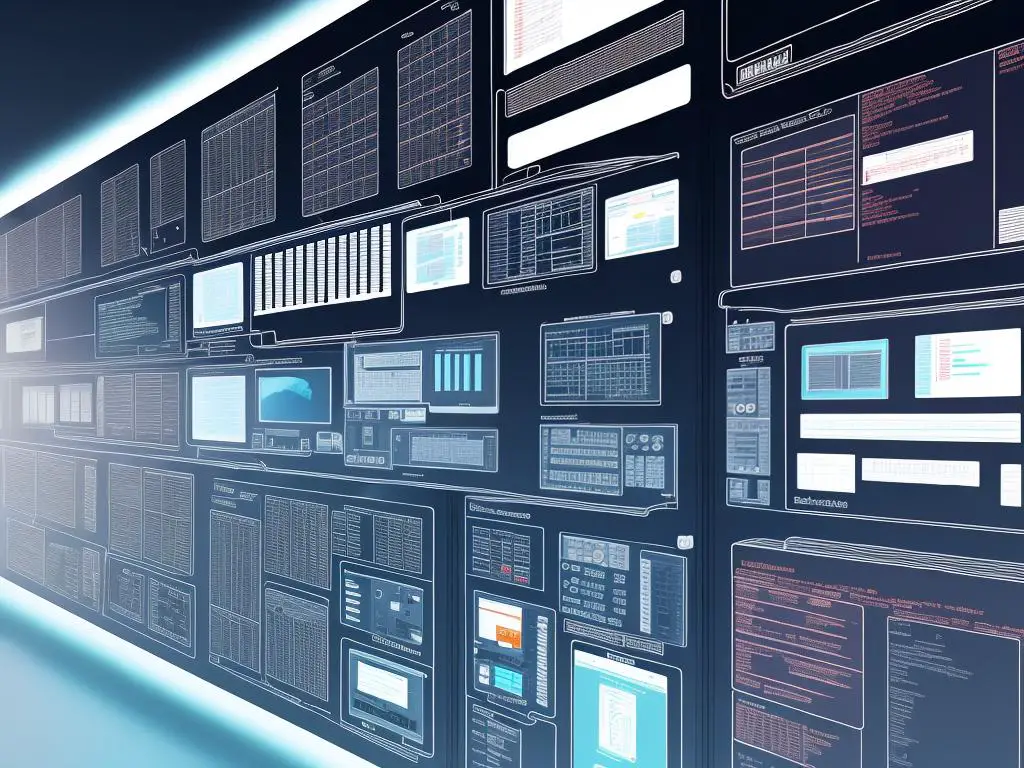
As we navigate through the realms of technological advancements, it becomes evident that the fusion of substation automation and the Internet of Things is not a mere possibility, but a transformative reality. While the journey confronts us with various challenges related to cost, compatibility, and security, the dynamic and adaptive nature of technology itself offers novel solutions. As we continue to enhance the intelligence of substations with IoT, we move towards a future where electrical systems are more reliable, efficient, and ultimately, more in tune with the evolving digital world. Subsequently, we uncover a shift in perspective, from viewing these technologies as standalone entities, to an intertwined net of innovation waiting to be fully explored and realized.
Overcoming Hurdles in Substation Automation
Overcoming Hurdles in Substation Automation: The evolution of power systems has led to the emergence of substation automation, an integral aspect of the modern energy sector poised to revolutionize how electricity is managed and distributed. Substation automation leverages cutting-edge technology, software, hardware, and communication systems to optimize efficiency, ensure reliability, and pave the way for smart grids. This process, however, is accompanied by a plethora of technical, human, financial, and regulatory challenges that must be navigated for successful implementation. This examination dives into the intricacies of such automation, sheds light on the issues faced, and provides insights on overcoming these barriers.
Understanding Substation Automation Overcoming Hurdles in Substation Automation
What is Substation Automation?
Substation automation is a method of using data from Intelligent Electronic Devices (IEDs), control and automation capabilities within the substation, and control commands from remote users to control and optimize the assets within the substation system. It’s an integral part of the smart grid systems that modern society is growing increasingly reliant upon. This technology has revolutionized the manner in which substations operate, leading to increased efficiency, reliability, and control.
Components Involved in Substation Automation
A substation automation system is typically a combination of numerous different types of equipment and software. This may include microprocessor-based smart devices, control and managing systems, and communication systems. The smart devices and sensors collect data from the substation and relay it to a central controller, where the information is then used to optimize substation performance.
The automation systems used can vary greatly depending on the specific needs and resources of the substation, but they generally aim to increase the operational efficiency and safety of the power system.
Understanding the Challenges
Despite its benefits and advancements, substation automation is not without its challenges. Implementation of this technology presents a range of technically complex and tricky obstacles.
Technical Challenges
One of the biggest technical challenges with substation automation is that it requires a significant upgrade in infrastructure. Implementing this technology often requires the replacement of old electromechanical devices with modern, microprocessor-based devices. This can be costly and time-consuming. Moreover, many of these new devices need to be designed to continue supporting legacy protocols while also supporting the newer, standardized protocols.
Enhancing Efficiency and Safety: The Power of HMI Software
Another technical challenge is related to the cyber security of the automated substation. The more interconnected the systems are, the higher the risk that they can be compromised by a cyber-attack. Control systems, communication networks, and even the power generation systems themselves can all be vulnerable.
Operational Challenges
There are also a number of operational and organizational challenges that can arise when implementing substation automation. One of the main operational challenges is to properly train staff to understand and operate the new systems. As with any new technology, there can be a steep learning curve and resistance to change.
Further, another challenge is dealing with maintenance of the new devices and systems. With the high rate of technological advances, equipment can quickly become outdated, requiring continuous up-gradation. This can place a heavy burden on both the financial resources and the manpower of the organization.
Environmental Challenges
Integrating renewable energy resources like solar and wind power into the grid further complicates substation automation. These sources bring variable and unpredictable power into the grid, making it more difficult to balance supply and demand.
Quality of Service
As reliability and quality of service are critical for utilities, another challenge is ensuring the automated system increases reliability without leading to a degradation in service quality. As automation systems are complex and involve a variety of technologies and protocols, there can be consequences for the quality of service when problems arise in the system.
Substation Automation at a Glance
Substation automation is an advanced technology designed to bolster the efficacy and reliability of energy grids. Nevertheless, its adoption is fraught with challenges. These span from technical complexities to operational hindrances and the integration with renewable energy sources, all of which must be adroitly navigated for efficient, secure, and successful automation. Despite such hurdles, substation automation remains a pivotal stride towards the future of power distribution and needs to be tackled judiciously and strategically.
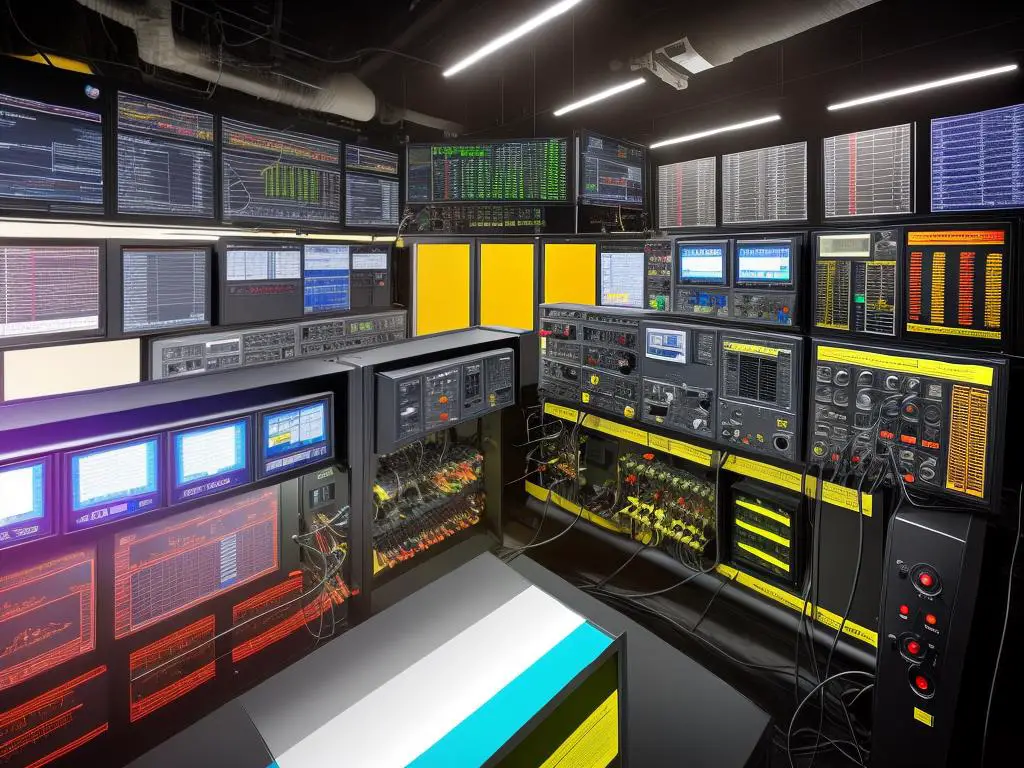
Technological Challenges in Substation Automation
Decoding Substation Automation
Substation automation is a culmination of numerous intricate technological elements such as programmable logical controllers (PLC), intelligent electronic devices (IED), and the Human Machine Interface (HMI), among others. These diverse systems are interconnected to work in harmony and enable a seamless transition in power transmission and distribution.
The Challenge of System Interoperability
One of the foremost challenges in substation automation is system interoperability. The various components and systems involved in substation automation often originate from different manufacturers with their unique programming standards. These programming disparities cause a significant issue when trying to synchronize and operate them as a single unified system. Solutions to this issue require a universal standard that manufacturers can follow making all components interoperable.
Data Handling and Communication
Another critical technological challenge in substation automation is data handling and communication. These automated systems generate massive volumes of data requiring swift and accurate processing for effective operation. The responsibility of receiving, interpreting, and communicating this data between different devices and systems is a daunting task.
The complexity of this task exacerbates when data formats and communication protocols differ between devices, leading to possible misinterpretation or loss of data. Therefore, it is vital to have a robust and efficient communication infrastructure in place that handles diverse data types and ensures seamless flow and precise interpretation.
Real-Time Operation
Electric substations are expected to function in real-time, meaning they need to respond and adapt to changes instantly. This necessity presents a significant challenge since not all components within the automated system may operate at the same speed or efficiently handle real-time data sharing and power adjustments. A small lag or miscommunication can result in significant setbacks like power outages, affecting a vast number of users.
Understanding Substation Automation & IoT Concepts: A Complete guide for beginner
Cybersecurity Issues
Lastl, with the increasing digitization of substations, the threat of cyberattacks is a formidable challenge. Cyber attackers can exploit the vulnerabilities in an automated substation system to cause blackouts or even worse. The importance of robust, effective cybersecurity measures in substation automation cannot be overstated.
Implementing such measures involves not just protecting the system from potential threats but also having a disaster recovery plan in place in case of any breaches. With an effective security plan, the system gains resilience against possible attacks and ensures continuous, safe operations.
Unlocking the Future Potential
Even with current challenges, evolving technology hints at a remarkable future for substation automation. The potential for integrating artificial intelligence and machine learning into routine operations, accelerating response time, and bolstering security greatly is indeed an exciting leap forward. Persistent research and groundbreaking innovations in this realm are pivotal to surmount existing obstacles and to fully harness the potential power of substation automation.

Human Factors and Substation Automation
Human Influence in a Technical Domain
At face value, automation within the seemingly mechanical and stoic environment of substations would appear entirely technical. While the significance of advanced technology as the driving force behind this transition is undeniable, there’s another dimension just as critical and often underemphasized – the human factor.
The Need for Training
In the coil of wires, switches, and transformers, human beings are the invisible connectors. They align the conductors and control the flow of electricity. But as substations steer towards automation, the role of these individuals twists and bends. The traditional methods of observation and physical adjustments give way to digital controls and complex software. It demands a fresh set of skills, a new understanding of how grids operate, thus illustrating the pressing need for comprehensive training.
These courses should ideally encompass both theoretical lessons and practical scenarios. Technical knowledge should walk hand in hand with real-life applications to facilitate a smooth transition from old frameworks to the new automation systems.
Overcoming Staff Resistance
In the quiet echo of substation chambers, resistance sometimes comes in the shape of currents against transformers, but in the journey of automation, it also thrives within the minds of working staff. Change, even though exciting, can be intimidating. There’s fear hidden in the folds of unfamiliarity – fear of redundancy, or of failing to adapt to the new methods.
Winning over this mental resistance is crucial in the road towards successful substation automation. Open conversations, reassurances about job security, and a step-by-step introduction to the modernized systems can help in this regard, making staff members active participants in the evolution, instead of passive bystanders caught in the whirlwind of automation.
Bridging the Skills Shortage
The electric hum of substations becomes a melody only when the right hands guide the symphony. But with automation, there’s a skills shortage in the market, a gap that requires attention. Demand for individuals who possess both electrical knowledge and software expertise will rise.
Collaborations with academic institutions could help prepare the upcoming workforce. Incorporating relevant modules within curriculums can supply a stream of skilled professionals ready to take on the intricacies of automated substations – ensuring the symphony not only continues but evolves into a more harmonious melody.
What is Remote Terminal Unit? A Basic Guide
New Work Styles
Like the hum of a substation indicating the flow of power, the buzz of human activity keeps the system alive. But as automation steps in, work styles wave goodbye to the traditional methods. Processes become more remote, demands more instantaneous, and decisions more data-driven.
It is a shift that requires, more than anything, adaptability. Work schedules, reporting protocols, even communication channels may have to be revised. Coordination within the team as well as with external stakeholders will call for a deep understanding of the new system. It will be a transformation, not just of the substations, but also of the way humans interact with this vast, electrical network.
Substation automation presents a compelling testament to how technology is shaping our world, but more importantly, to the resilience and adaptability of the human spirit. Although the evolution of substation automation brings new challenges and stresses, it also provides us an opportunity to showcase our problem-solving abilities and innovative mindset.

Financial and Regulatory Challenges
Navigating Uncharted Waters
The landscape of substation automation is like navigating uncharted waters, where only the brave or resource-rich venture. It is a sector marked by enormous investment risks and equally substantial potential rewards. Financial hurdles and regulatory compliance issues frequently stand as significant barriers, shaping a complex matrix of challenges that power companies must adeptly conquer.
Capital Hungry Beast
Substation automation is a capital-hungry beast, demanding a substantial initial investment for equipment and software, and equally draining operational and maintenance expenses. These costs can often deter energy companies, particularly smaller ones, from expanding their horizons into this groundbreaking realm of energy supply.
However, numerous funding options do exist, ranging from self-generated company funds to government grants, private investments, and loans. Each funding option comes with its own set of pros and cons to consider. For instance, self-generated funds ensure independence, but limit the magnitude of potential investment, while loans provide a larger capital base but come with interest rates and repayment obligations.
The Regulatory Dance
The intertwining of power supply and advanced technology also initiates a complex legal dance. Not only do energy companies have to follow the technical guidelines laid out by authorities such as the North American Electric Reliability Corporation, they also must abide by an array of federal, state, and local regulations.
These guidelines and regulations are a constantly moving target, their aim often swaying based on political trends. Energy companies constantly find themselves having to adapt to new directives and standards that impact their operating procedures, technological choices, and ultimately, their bottom line.
Moreover, the regulatory environment is not uniform across states or countries. This creates a particularly challenging landscape for energy companies that operate in multiple jurisdictions, with each jurisdiction adding its own layer of rules to light the path of substation automation.
Navigating the Network
Despite operating in an environment filled with constraints and complexities, energy companies continue to push the boundaries with their innovative approaches to substation automation. Their successful strategies commonly consist of the following elements: maintaining open communication with regulatory bodies to stay abreast with policy changes, investing in adaptable technology solutions that can accommodate regulatory shifts, and implementing smart financial strategies to sustain the advancement of power supply.
These companies, the torchbearers of substation automation, are exploring an untreaded territory, with substantial expenses and regulatory uncertainties as part of the trail. However, the journey promises the potential to revolutionize the energy industry.
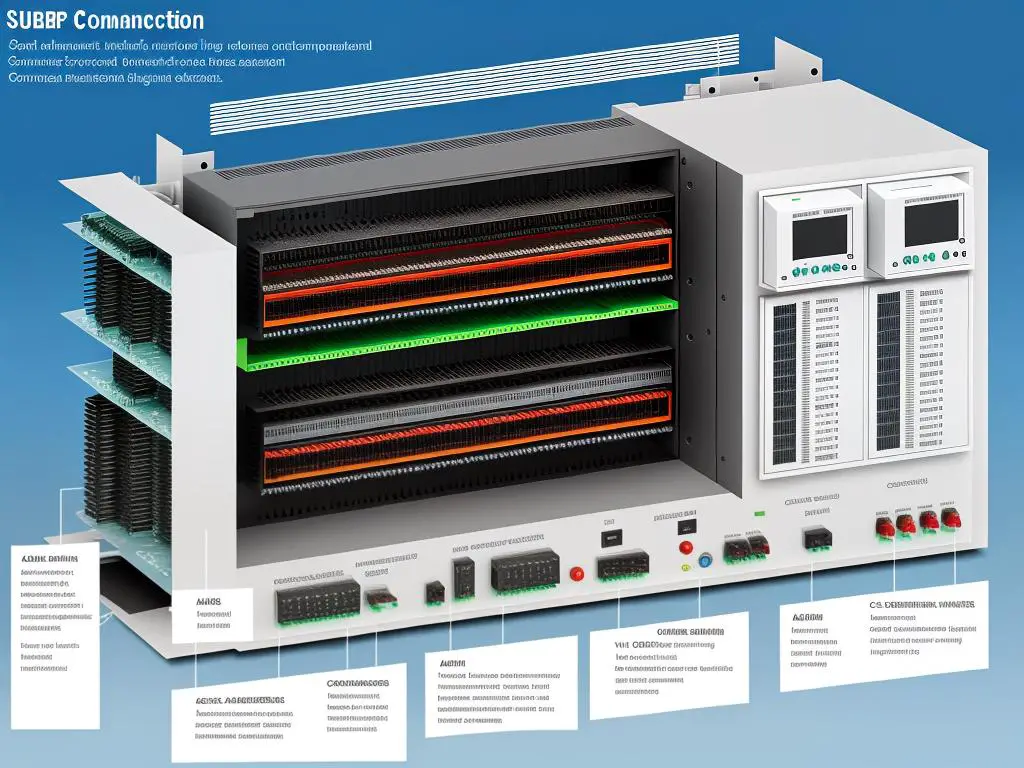
Overcoming the Barriers to Substation Automation
Tackling the Challenges Head-On
Substation automation is undeniably a vital facet of the contemporary power supply industry, but it is replete with its share of obstacles. The industry’s frontrunners are persistently designing solutions to overcome such challenges. Their key areas of focus include technological advancements, employee skills enhancement, innovative funding schemes, and lobbying for more supportive regulatory frameworks.
The Technological Obstacle
Like a highway under construction – promising smoother travel someday but presently a cause of delays – new technology can present a two-fold problem. On one side, there is the issue of compatibly integrating newer automated systems with older existing infrastructure. And then there’s the cost of these advancements, often so costly that it becomes a formidable barrier to substation automation.
To surmount these problems, power industry leaders are investing in research and development for less expensive and more efficient automation technologies. While this isn’t an overnight fix, it promises long-term solutions. Application of smart grid technology in substations has been widely explored, lauded for its potential to improve efficiency and reliability while significantly cutting costs.
Upskilling the Workforce
Just as a sports car is wasted in the hands of someone who only knows how to ride a bicycle, so are sophisticated automation systems if the staff don’t possess the right expertise. As technology advances, so must the skills of the workforce. Thus, upskilling staff becomes both a challenge and a solution in the substation automation arena.
Considered an integral part of the modernization process, workforce education and retraining programs are being actively implemented across the sector. Through these programs, staff can keep abreast with the latest developments in the automation technology landscape, and consequently, maximize these technologies’ advantages effectively.
Funding Models and Regulatory Frameworks
Money and law – the dual gatekeepers of any initiative’s success. Judicious planning of investment models and advocating for supportive regulatory frameworks are essential strategies in overcoming challenges in substation automation.
Innovative funding options, such as public-private partnerships, have shown promise, providing much-needed monetary resources to finance technological upgrades. These partnerships not only resolve the immediate financial challenges but also foster a cooperative environment in advancing substation automation.
Regulations, though designed for control and protection, can sometimes turn restrictive, particularly when they lag behind fast-paced technological advancements. To this end, industry leaders must continually engage with policymakers, articulating the need for regulations that support and encourage substation automation innovations. The ideal regulatory framework would foster innovation while ensuring safety and delivering valuable services to consumers.
In this ongoing stride towards a more automated future, industry pioneers are navigating through a maze of challenges. Yet, by leveraging technological progress, investing in workforce development, pioneering flexible funding models, and advocating for supportive regulatory frameworks, they’re turning these challenges into stepping-stones, inching us closer to a more energy-efficient future.
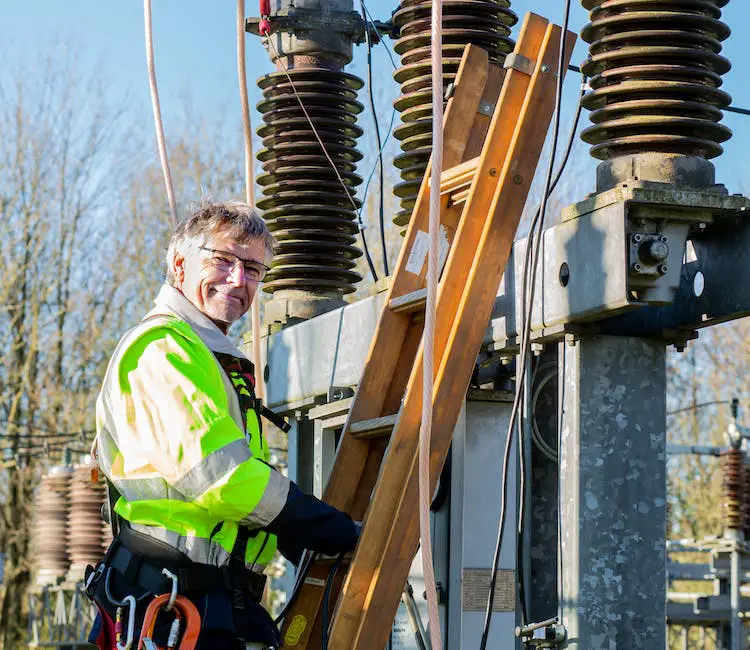
Substation automation stands at the confluence of technology, people, finance, and regulations – each bringing its own set of challenges yet offering immense opportunities for optimization and revolutionizing power systems management. To fully capitalize on this potential, it is imperative for energy companies to understand these challenges. By addressing interoperability, managing data flow, upgrading cyber-security, focusing on staff training and adaptability, managing costs, seeking innovative funding, and navigating regulatory hurdles – we can ensure that the path towards substation automation leads to the promised outcomes of efficiency, resilience and the creation of a truly smart grid equipped to meet the energy demands of the future.
What is the difference between SCADA and RTU?

What is the difference between SCADA and RTU?: SCADA (Supervisory Control and Data Acquisition) and RTU (Remote Terminal Unit) are both key components of modern industrial control and automation systems. While they both play important roles in such systems, they differ in their functions and capabilities.
IEC 101 vs. IEC 104: Understanding the Differences
What is the difference between SCADA and RTU?
A SCADA (Supervisory Control and Data Acquisition) system is a software package used to monitor and control industrial processes and equipment. It provides a central control platform that gathers and processes data from field devices, such as sensors and actuators, and presents it to operators in a graphical user interface (GUI). The GUI allows operators to monitor the system in real-time, detect abnormalities, and respond to alarms.
One of the primary functions of a SCADA system is data acquisition. It collects data from various sensors and devices located throughout the industrial process, such as temperature, pressure, flow rate, and level measurements. This real-time data is crucial for operators to make informed decisions and take appropriate actions.
Once the data is acquired, the SCADA system processes it to provide useful information and insights. It performs calculations, statistical analysis, and data filtering to identify patterns, trends, and anomalies. For example, it can generate reports on equipment performance, energy consumption, production efficiency, and other key performance indicators.
The processed data is then visualized and presented to operators through the GUI. The GUI typically consists of different graphical elements, such as real-time displays, trend charts, tables, and alarm panels. It allows operators to have a comprehensive overview of the industrial process and easily identify any abnormalities or issues that require attention.
In addition to data visualization, a SCADA system also enables control functionalities. Operators can use the GUI to adjust setpoints, change operating parameters, and initiate actions such as starting or stopping equipment. These control actions are sent back to the field devices through the SCADA system, ensuring that the desired changes are implemented in the industrial process.
Enhancing Efficiency and Safety: The Power of HMI Software
Overall, a well-designed and properly implemented SCADA system plays a crucial role in optimizing industrial processes. It enhances operational efficiency, improves productivity, reduces downtime, and enhances safety. The ability to monitor and control multiple processes from a centralized platform empowers operators to make data-driven decisions, leading to improved overall performance and profitability.

On the other hand, an RTU (Remote Terminal Unit) is a hardware device that is installed at a remote site to provide communication and control between the central SCADA (Supervisory Control and Data Acquisition) system and field devices. An RTU plays a crucial role in various industries such as oil and gas, water and wastewater, power generation, and manufacturing.
An RTU typically includes input/output (I/O) channels for interfacing with sensors and actuators, ensuring seamless data acquisition and control capabilities. It acts as a bridge between the SCADA system and the various field devices, enabling the exchange of data in real-time. The I/O channels provide the RTU with the ability to monitor analog and digital signals from sensors, as well as send control signals to actuators for performing specific actions.
In addition to its I/O capabilities, an RTU is equipped with a central processing unit (CPU) responsible for data processing and executing control tasks. The CPU performs calculations, applies algorithms, and executes custom logic to make informed decisions based on the data collected from the field devices. This processing power enables the RTU to optimize control strategies, adhere to safety protocols, and ensure efficient operation of the entire system.
Understanding Substation Automation & IoT Concepts: A Complete guide for beginner
Furthermore, an RTU features communication interfaces that facilitate the transmission of data between the RTU and the central SCADA system. These interfaces can vary depending on the application and requirements, but commonly include protocols such as Modbus, DNP3, and OPC to ensure compatibility and interoperability. The RTU securely transmits data to the SCADA system, allowing operators and engineers to monitor and control field devices in real-time from a central location.
What is Remote Terminal Unit? A Basic Guide
In summary, an RTU is an integral component of a SCADA system, providing essential data acquisition, processing, and control capabilities. Its role is to collect data from field devices, such as sensors and actuators, and transmit it to the central SCADA system. By doing so, it enables remote monitoring, control, and optimization of industrial processes, contributing to increased operational efficiency, enhanced safety, and improved decision-making.
In summary, SCADA and RTU are both essential components of industrial control and automation systems, but they have different roles and capabilities. SCADA systems provide the central control platform for monitoring and controlling industrial processes, while RTUs provide the interface between the central SCADA system and field devices.






You must be logged in to post a comment.